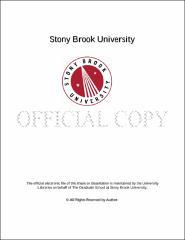| dc.identifier.uri | http://hdl.handle.net/11401/77397 | |
| dc.description.sponsorship | This work is sponsored by the Stony Brook University Graduate School in compliance with the requirements for completion of degree. | en_US |
| dc.format | Monograph | |
| dc.format.medium | Electronic Resource | en_US |
| dc.language.iso | en_US | |
| dc.publisher | The Graduate School, Stony Brook University: Stony Brook, NY. | |
| dc.type | Dissertation | |
| dcterms.abstract | Research on insect melanism has been informative in understanding how evolutionary mechanisms can produce phenotypic diversity. My dissertation examines how genes contributing to the pigment biosynthesis pathway may be contributing to natural variation of pigmentation traits in Drosophila melanogaster. I uncovered significant variation in abdominal and thoracic pigmentation both within and among populations of D. melanogaster in the eastern United States. I closely examined how polymorphisms within the pigmentation genes, ebony, pale, Ddc, and tan are associated with pigmentation traits. I also looked for patterns of nucleotide diversity in each gene as well as evidence for selection. Each of the genes had loci that were significantly associated with pigmentation, with some being in regions that may be experiencing possible balancing or purifying selection. Adult expression of ebony and pale were also significantly correlated with pigmentation levels. These results suggest that various components in the pigmentation pathway are evolving together in order to produce phenotypic variation in these populations. Additionally, there was evidence for independent regulation of pigmentation expression in the thorax and the abdomen. Analysis of pigmentation phenotypes has revealed significant geographic patterns with a possible cline in thoracic traits. We also sequenced a group of alleles of the ebony and pale genes in these populations to examine clinal patterns and confirm associations with pigmentation traits. My work has the potential to increase the understanding of how polymorphisms at the nucleotide sequence level contribute to population level differences and possibly adaptation in D. melanogaster and other insect species. | |
| dcterms.available | 2017-09-20T16:52:37Z | |
| dcterms.contributor | Futuyma, Douglas | en_US |
| dcterms.contributor | TRUE, John R. | en_US |
| dcterms.contributor | Schmidt, Paul. | en_US |
| dcterms.contributor | Eanes, Walter F. Eanes F. | en_US |
| dcterms.creator | Ng, Rocio Siu | |
| dcterms.dateAccepted | 2017-09-20T16:52:37Z | |
| dcterms.dateSubmitted | 2017-09-20T16:52:37Z | |
| dcterms.description | Department of Ecology and Evolution. | en_US |
| dcterms.extent | 149 pg. | en_US |
| dcterms.format | Monograph | |
| dcterms.format | Application/PDF | en_US |
| dcterms.identifier | http://hdl.handle.net/11401/77397 | |
| dcterms.issued | 2015-08-01 | |
| dcterms.language | en_US | |
| dcterms.provenance | Made available in DSpace on 2017-09-20T16:52:37Z (GMT). No. of bitstreams: 1
Ng_grad.sunysb_0771E_12084.pdf: 3720532 bytes, checksum: b141ce1b7e4e182f6eacb7989e00acc3 (MD5)
Previous issue date: 2014 | en |
| dcterms.publisher | The Graduate School, Stony Brook University: Stony Brook, NY. | |
| dcterms.subject | Evolution, Evolutionary Genetics, Genetics, Population Genetics | |
| dcterms.subject | Evolution & development | |
| dcterms.title | The evolution of pigmentation traits in natural populations of Drosophila melanogaster | |
| dcterms.type | Dissertation | |

